SOLVED PROBLEMS
This section in each chapter contains a few solved problems that show how to approach the problem sets that follow. The purpose of the problem sets is to challenge your understanding of the genetic principles learned in the chapter. The best way to demonstrate an understanding of a subject is to be able to use that knowledge in a real or simulated situation. Be forewarned that there is no machine-
Here is some general advice before beginning. First, it is absolutely essential to read and understand all of the problem. Most of the problems use data taken from research that somebody actually carried out: ask yourself why the research might have been initiated and what was the probable goal. Find out exactly what facts are provided, what assumptions have to be made, what clues are given in the problem, and what inferences can be made from the available information. Second, be methodical. Staring at the problem rarely helps. Restate the information in the problem in your own way, preferably using a diagrammatic representation or flowchart to help you think out the problem. Good luck.
72
SOLVED PROBLEM 1. Crosses were made between two pure lines of rabbits that we can call A and B. A male from line A was mated with a female from line B, and the F1 rabbits were subsequently intercrossed to produce an F2. Three-
Solution
The first time that the experiment was done, the breeders would have been perfectly justified in proposing that a pair of alleles determine white versus yellow body fat because the data clearly resemble Mendel’s results in peas. White must be dominant, and so we can represent the white allele as W and the yellow allele as w. The results can then be expressed as follows:
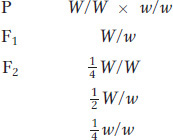
No doubt, if the parental rabbits had been sacrificed, one parent (we cannot tell which) would have been predicted to have white fat and the other yellow. Luckily, the rabbits were not sacrificed, and the same animals were bred again, leading to a very interesting, different result. Often in science, an unexpected observation can lead to a novel principle, and, rather than moving on to something else, it is useful to try to explain the inconsistency. So why did the 3:1 ratio disappear? Here are some possible explanations.
First, perhaps the genotypes of the parental animals had changed. This type of spontaneous change affecting the whole animal, or at least its gonads, is very unlikely, because even common experience tells us that organisms tend to be stable to their type.
Second, in the repeat, the sample of 22 F2 animals did not contain any yellow fat simply by chance (“bad luck”). This explanation, again, seems unlikely, because the sample was quite large, but it is a definite possibility.
A third explanation draws on the principle that genes do not act in a vacuum; they depend on the environment for their effects. Hence, the formula “genotype + environment = phenotype” is a useful mnemonic. A corollary of this formula is that genes can act differently in different environments; so
genotype 1 + environment 1 = phenotype 1
and
genotype 1 + environment 2 = phenotype 2
In the present problem, the different diets constituted different environments, and so a possible explanation of the results is that the homozygous recessive w/w produces yellow fat only when the diet contains fresh vegetables. This explanation is testable. One way to test it is to repeat the experiment again and use vegetables as food, but the parents might be dead by this time. A more convincing way is to breed several of the white- white fat and
white fat and  yellow fat.
yellow fat.
If this outcome did not happen and no progeny having yellow fat appeared in any of the matings, we would be forced back to the first or second explanation. The second explanation can be tested by using larger numbers, and if this explanation doesn’t work, we are left with the first explanation, which is difficult to test directly.
As you might have guessed, in reality, the diet was the culprit. The specific details illustrate environmental effects beautifully. Fresh vegetables contain yellow substances called xanthophylls, and the dominant allele W gives rabbits the ability to break down these substances to a colorless (“white”) form. However, w/w animals lack this ability, and the xanthophylls are deposited in the fat, making it yellow. When no xanthophylls have been ingested, both W/ – and w/w animals end up with white fat.
SOLVED PROBLEM 2. Phenylketonuria (PKU) is a human hereditary disease resulting from the inability of the body to process the chemical phenylalanine, which is contained in the protein that we eat. PKU is manifested in early infancy and, if it remains untreated, generally leads to mental retardation. PKU is caused by a recessive allele with simple Mendelian inheritance.
A couple intends to have children but consult a genetic counselor because the man has a sister with PKU and the woman has a brother with PKU. There are no other known cases in their families. They ask the genetic counselor to determine the probability that their first child will have PKU. What is this probability?
Solution
What can we deduce? If we let the allele causing the PKU phenotype be p and the respective normal allele be P, then the sister and brother of the man and woman, respectively, must have been p/p. To produce these affected persons, all four grandparents must have been heterozygous normal. The pedigree can be summarized as follows:
73

When these inferences have been made, the problem is reduced to an application of the product rule. The only way in which the man and woman can have a PKU child is if both of them are heterozygotes (it is obvious that they themselves do not have the disease). Both the grandparental matings are simple Mendelian monohybrid crosses expected to produce progeny in the following proportions:
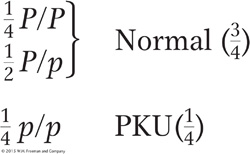
We know that the man and the woman are normal, and so the probability of each being a heterozygote is 2/3 because, within the P/– class, 2/3 are P/p and 1/3 are P/P.
The probability of both the man and the woman being heterozygotes is 2/3 × 2/3 = 4/9. If both are heterozygous, then one-
SOLVED PROBLEM 3. A rare human disease is found in a family as shown in the accompanying pedigree.
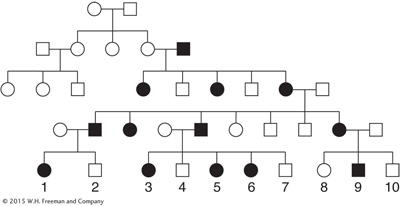
Deduce the most likely mode of inheritance.
What would be the outcomes of the cousin marriages 1 × 9, 1 × 4, 2 × 3, and 2 × 8?
Solution
The most likely mode of inheritance is X-
linked dominant. We assume that the disease phenotype is dominant because, after it has been introduced into the pedigree by the male in generation II, it appears in every generation. We assume that the phenotype is X linked because fathers do not transmit it to their sons. If it were autosomal dominant, father- to- son transmission would be common. In theory, autosomal recessive could work, but it is improbable. In particular, note the marriages between affected members of the family and unaffected outsiders. If the condition were autosomal recessive, the only way in which these marriages could have affected offspring is if each person marrying into the family were a heterozygote; then the matings would be a/a (affected) × A/a (unaffected). However, we are told that the disease is rare; in such a case, heterozygotes are highly unlikely to be so common. X-
linked recessive inheritance is impossible, because a mating of an affected woman with a normal man could not produce affected daughters. So we can let A represent the disease- causing allele and a represent the normal allele. 1 × 9: Number 1 must be heterozygous A/a because she must have obtained a from her normal mother. Number 9 must be A/Y. Hence, the cross is A/a ♀ × A/Y ♂.
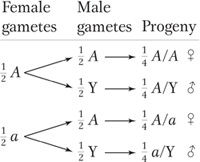
1 × 4: Must be A/a ♀ × a/Y ♂.
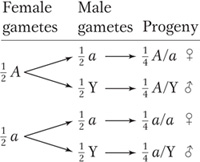
2 × 3: Must be a/Y ♂ × A/a ♀ (same as 1 × 4).
2 × 8: Must be a/Y ♂ × a/a ♀ (all progeny normal).
74